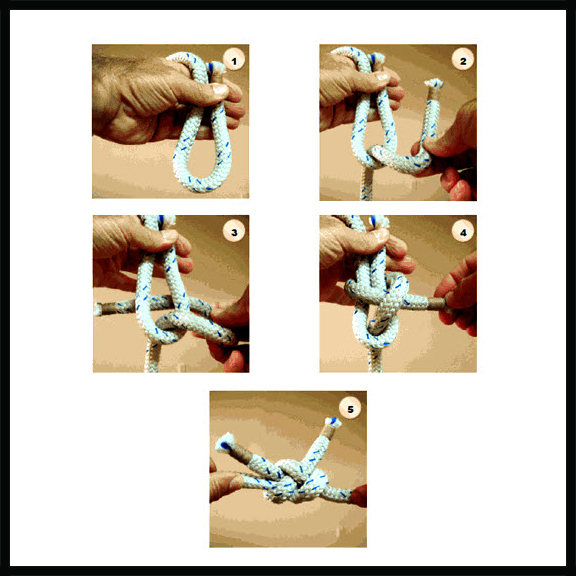Here’s another great tip from our friend Capt. John of skippertips.com...
We needed to move the big 44 foot cutter fast to make room for another boat. And we needed a super long docking line to pull the boat across the slip to the opposite side. What fast, easy-to-tie sailing knot would work? Grab some line, follow along and learn to tie this easy knot in just a matter of seconds!
In the illustration above, the single becket or sheet bend will be tied with two lines of equal diameter. If you use two lines or unequal diameter, always thread with the smaller diameter line. Hold the larger diameter line stationary (the “teardrop” in the illustration). Take care to cinch up the knot when done to remove all slack. This keeps the knot compact and secure (step 5 in the illustration).
Practice Until You Can Tie it Blindfolded!
Use the becket bend (also called “sheet bend”) to join together two lines. The single becket or sheet bend will the the more temporary knot. In a previous article, we discussed the double becket or double sheet bend (see “Related Articles” below). Use the single becket to join a heaving line to a docking line to get the line ashore or when you are in a hurry and need a secure knot that will not be under shock loads (tension and slack, tension and slack).
In the example above, we used the single becket and it worked just fine to get the boat moved safe and sound. Practice this until you can do it with your eyes closed. On a dark, windy, rainy night, you may need to do just that!
Follow These Three Fast Steps
Remember that you will often need to join two pieces of line that are of different diameters. Take care to thread with the smaller line. Always. You want the smaller line to grip the stationary “teardrop” line (see below). Otherwise, this knot will not hold. When you practice, use a piece of large diameter line and one of smaller diameter.
Just for fun, try to do the opposite–thread with the larger diameter of the two lines. You will see right away that the large diameter line will not hold well, and the sailing knot will spill (untie itself) in no time flat if you jerk and slack the line a few times. Plant this memory key in your mind now: “Thread with the Thin Line!”.
1. Make a Teardrop
Form an upside down teardrop (or raindrop) shape with the larger of the two lines–or one of two lines if they’re the same diameter. Hold the teardrop in your non-dominant hand with the fat part of the drop facing down (illustration 1).
2. Pass the Becket
Pull the other line (or the smaller line) through the back of the teardrop and bring several inches toward you. Form a loose loop on one side of the teardrop. Pass the line around the back of the teardrop and through the loop. (illustrations 2, 3, and 4).
3. Cinch Up the Knot
Make your knot tight and compact. Pull on both standing parts and bitter ends a bit at a time. You want the knot to stay put under surge or shock load (illustration 5).
~~~~~~~~~~~~~~~~~~~~
Add this powerhouse sailing knot to your “must know” list of marine knots today. Arm yourself with the knowledge to choose the best knot for the application aboard your small cruising sailboat–wherever in the world you choose to go sailing or cruising!












